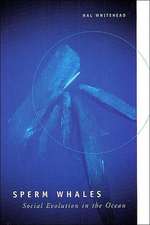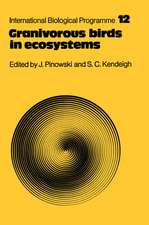Hyman's Comparative Vertebrate Anatomy
Editat de Marvalee H. Wakeen Limba Engleză Paperback – 30 iun 1992
The purpose of this book, now in its third edition, is to introduce the morphology of vertebrates in a context that emphasizes a comparison of structire and of the function of structural units. The comparative method involves the analysis of the history of structure in both developmental and evolutionary frameworks. The nature of adaptation is the key to this analysis. Adaptation of a species to its environment, as revealed by its structure, function, and reproductive success, is the product of mutation and natural selection–the process of evolution. The evolution of structure and function, then, is the theme of this book which presents, system by system, the evolution of structure and function of vertebrates. Each chapter presents the major evolutionary trends of an organ system, with instructions for laboratory exploration of these trends included so the student can integrate concept with example.
Preț: 484.48 lei
Preț vechi: 629.20 lei
-23% Nou
Puncte Express: 727
Preț estimativ în valută:
92.72€ • 95.78$ • 77.16£
92.72€ • 95.78$ • 77.16£
Carte tipărită la comandă
Livrare economică 25 martie-08 aprilie
Preluare comenzi: 021 569.72.76
Specificații
ISBN-13: 9780226870137
ISBN-10: 0226870138
Pagini: 795
Ilustrații: 243 figures, 5 tables
Dimensiuni: 171 x 254 x 46 mm
Greutate: 1.32 kg
Ediția:1
Editura: University of Chicago Press
Colecția University of Chicago Press
ISBN-10: 0226870138
Pagini: 795
Ilustrații: 243 figures, 5 tables
Dimensiuni: 171 x 254 x 46 mm
Greutate: 1.32 kg
Ediția:1
Editura: University of Chicago Press
Colecția University of Chicago Press
Cuprins
Preface to the Third Edition
1. General Considerations of Animal Form
A. Introduction
B. Major Considerations in Morphology
References
2. The Phylum Chordata: Classification, External Anatomy, and Adaptive Radiation
A. Classification
B. Adaptive Radiation
C. What Is a Chordate?
D. Characteristics of the Vertebrates
E. The Vertebrate Groups
F. Patterns in Vertebrate Evolution
References
3. Essential Features of Lower Types
A. Phylum Hemichordata: A Prechordate Group
B. The Lower Chordates, Subphylum Urochordata
C. The Lower Chordates, Subphylum Cephalochordata
D. Class Cyclostomata
References
4. General Features of Chordate Development
A. The Egg
B. Cleavage and Blastulation
C. Gastrulation
D. Formation of Mesoderm
E. Formation of the Neural Tube and Notochord
F. Cells and Tissue Interactions
G. Differentiation and Derivation
H. Sources of Energy during Development
References
5. The Comparative Anatomy of the Integumental Skeleton
Part 1: The Underlying Homology
A. Introduction
B. Some Developmental Considerations
C. Summary of Part 1
Part 2: The Variation in End Products
D. The Integumental-Environmental Interface
E. The Keratinized Integumental Skeleton
F. The Ossified Integumental Skeleton
G. Integumental Color
H. Summary of Part 2
References
6. The Endoskeleton: The Comparative Anatomy of the Vertebral Column and Ribs
A. General Considerations on the Endoskeleton
B. Anatomy and Embryonic Origin of Vertebrate and Ribs
C. Vertebral Columns of Some Archaic Fishes
D. Vertebral Column of the Dogfish
E. Vertebral Column of Teleosts
F. Endoskeletal Fin Supports of Fishes
G. Vertebral Column of Amphibia
H. Vertebral Column of Reptiles and Amniotes in General
I. Vertebral Column of Birds
J. Vertebral Column of Mammals
K. Summary
References
7. The Endoskeleton: The Comparative Anatomy of the Girdles, the Sternum, and the Paired Appendages
A. General Considerations
B. The Pelvic Girdle and the Posterior Appendages
C. The Pectoral Girdle, the Sternum, and the Anterior Paired Appendages
D. Some Variation of the Appendicular Skeleton in Tetrapods
E. Summary
References
8. The Endoskeleton: The Comparative Anatomy of the Skull and the Visceral Skeleton
A. Introduction: The Concept of the Skull
B. The Chondrocranium
C. The Splachnocranium
D. The Dermatocranium
E. The Composition of the Complete Skull: Characterization of the Primitive Tetrapod Skull
F. The Teeth
G. The Modern Amphibian Skull Exemplified by Necturus
H. The Reptilian Skull Exemplified by the Alligator or Caiman
I. The Mammalian Skull Exemplified by the Opossum and the Cat
J. Summary
References
9. The Comparative Anatomy of the Muscular System
A. Introduction
B. Generalized Vertebrate Musculature as Exemplified by the Dogfish
C. Early Tetrapod Musculature, Exemplified by Necturus
D. Reptilian Musculature
E. Avian Musculature
F. Mammalian Musculature
G. Summary
References
10. The Comparative Anatomy of the Coelom and of the Digestive and Respiratory Systems
A. Introduction
B. The Coelom and Mesenteries
C. The Digestive Tract and Associated Structures
D. Respiratory Structures
E. The Alimentary Canal
F. The Coelom and the Digestive and Respiratory Systems of Elasmobranchs
G. The Respiratory and Digestive Systems of a Bony Fish
H. The Coelom and the Digestive and Respiratory Systems of Necturus
I. The Coelom and the Digestive and Respiratory Systems of the Turtle
J. The Coelom and the Digestive and Respiratory Systems of the Pigeon
K. The Coelom and the Digestive and Respiratory Systems of Mammals
L. Summary
References
11. The Comparative Anatomy of the Circulatory System
A. Introduction
B. Parts of the Circulatory System
C. Development of the Vascular System
D. Structure and Evolution of the Vascular System
E. Functional Anatomy and the Evolution of the Heart
F. Special Adaptations of the Vascular System
G. The Circulatory System of Elasmobranchs
H. The Circulatory System of Necturus
I. The Circulatory System of the Turtle
J. The Circulatory System of the Pigeon
K. The Circulatory System of Mammals
L. Summary
References
12. The Comparative Anatomy of the Urogenital System
A. Introduction
B. The Urogenital System of Selachians
C. The Urogenital System of Necturus
D. The Urogenital System of the Turtle
E. The Urogenital System of the Pigeon
F. The Urogenital System of Mammals
G. Summary
References
13. The Comparative Anatomy of the Nervous System and the Sense Organs
A. General Considerations
B. The Nervous System and Sense Organs of Elasmobranchs
C. The Nervous System and Sense Organs of the Perch (Perca)
D. The Nervous System and Sense Organs of Necturus
E. The Nervous System and Sense Organs of the Painted Turtle (Chrysemys)
F. The Nervous System and Sense Organs of the Pigeon
G. The Nervous System and Sense Organs of Mammals
H. Summary
References
List of Contributors
Index
1. General Considerations of Animal Form
A. Introduction
B. Major Considerations in Morphology
References
2. The Phylum Chordata: Classification, External Anatomy, and Adaptive Radiation
A. Classification
B. Adaptive Radiation
C. What Is a Chordate?
D. Characteristics of the Vertebrates
E. The Vertebrate Groups
F. Patterns in Vertebrate Evolution
References
3. Essential Features of Lower Types
A. Phylum Hemichordata: A Prechordate Group
B. The Lower Chordates, Subphylum Urochordata
C. The Lower Chordates, Subphylum Cephalochordata
D. Class Cyclostomata
References
4. General Features of Chordate Development
A. The Egg
B. Cleavage and Blastulation
C. Gastrulation
D. Formation of Mesoderm
E. Formation of the Neural Tube and Notochord
F. Cells and Tissue Interactions
G. Differentiation and Derivation
H. Sources of Energy during Development
References
5. The Comparative Anatomy of the Integumental Skeleton
Part 1: The Underlying Homology
A. Introduction
B. Some Developmental Considerations
C. Summary of Part 1
Part 2: The Variation in End Products
D. The Integumental-Environmental Interface
E. The Keratinized Integumental Skeleton
F. The Ossified Integumental Skeleton
G. Integumental Color
H. Summary of Part 2
References
6. The Endoskeleton: The Comparative Anatomy of the Vertebral Column and Ribs
A. General Considerations on the Endoskeleton
B. Anatomy and Embryonic Origin of Vertebrate and Ribs
C. Vertebral Columns of Some Archaic Fishes
D. Vertebral Column of the Dogfish
E. Vertebral Column of Teleosts
F. Endoskeletal Fin Supports of Fishes
G. Vertebral Column of Amphibia
H. Vertebral Column of Reptiles and Amniotes in General
I. Vertebral Column of Birds
J. Vertebral Column of Mammals
K. Summary
References
7. The Endoskeleton: The Comparative Anatomy of the Girdles, the Sternum, and the Paired Appendages
A. General Considerations
B. The Pelvic Girdle and the Posterior Appendages
C. The Pectoral Girdle, the Sternum, and the Anterior Paired Appendages
D. Some Variation of the Appendicular Skeleton in Tetrapods
E. Summary
References
8. The Endoskeleton: The Comparative Anatomy of the Skull and the Visceral Skeleton
A. Introduction: The Concept of the Skull
B. The Chondrocranium
C. The Splachnocranium
D. The Dermatocranium
E. The Composition of the Complete Skull: Characterization of the Primitive Tetrapod Skull
F. The Teeth
G. The Modern Amphibian Skull Exemplified by Necturus
H. The Reptilian Skull Exemplified by the Alligator or Caiman
I. The Mammalian Skull Exemplified by the Opossum and the Cat
J. Summary
References
9. The Comparative Anatomy of the Muscular System
A. Introduction
B. Generalized Vertebrate Musculature as Exemplified by the Dogfish
C. Early Tetrapod Musculature, Exemplified by Necturus
D. Reptilian Musculature
E. Avian Musculature
F. Mammalian Musculature
G. Summary
References
10. The Comparative Anatomy of the Coelom and of the Digestive and Respiratory Systems
A. Introduction
B. The Coelom and Mesenteries
C. The Digestive Tract and Associated Structures
D. Respiratory Structures
E. The Alimentary Canal
F. The Coelom and the Digestive and Respiratory Systems of Elasmobranchs
G. The Respiratory and Digestive Systems of a Bony Fish
H. The Coelom and the Digestive and Respiratory Systems of Necturus
I. The Coelom and the Digestive and Respiratory Systems of the Turtle
J. The Coelom and the Digestive and Respiratory Systems of the Pigeon
K. The Coelom and the Digestive and Respiratory Systems of Mammals
L. Summary
References
11. The Comparative Anatomy of the Circulatory System
A. Introduction
B. Parts of the Circulatory System
C. Development of the Vascular System
D. Structure and Evolution of the Vascular System
E. Functional Anatomy and the Evolution of the Heart
F. Special Adaptations of the Vascular System
G. The Circulatory System of Elasmobranchs
H. The Circulatory System of Necturus
I. The Circulatory System of the Turtle
J. The Circulatory System of the Pigeon
K. The Circulatory System of Mammals
L. Summary
References
12. The Comparative Anatomy of the Urogenital System
A. Introduction
B. The Urogenital System of Selachians
C. The Urogenital System of Necturus
D. The Urogenital System of the Turtle
E. The Urogenital System of the Pigeon
F. The Urogenital System of Mammals
G. Summary
References
13. The Comparative Anatomy of the Nervous System and the Sense Organs
A. General Considerations
B. The Nervous System and Sense Organs of Elasmobranchs
C. The Nervous System and Sense Organs of the Perch (Perca)
D. The Nervous System and Sense Organs of Necturus
E. The Nervous System and Sense Organs of the Painted Turtle (Chrysemys)
F. The Nervous System and Sense Organs of the Pigeon
G. The Nervous System and Sense Organs of Mammals
H. Summary
References
List of Contributors
Index









